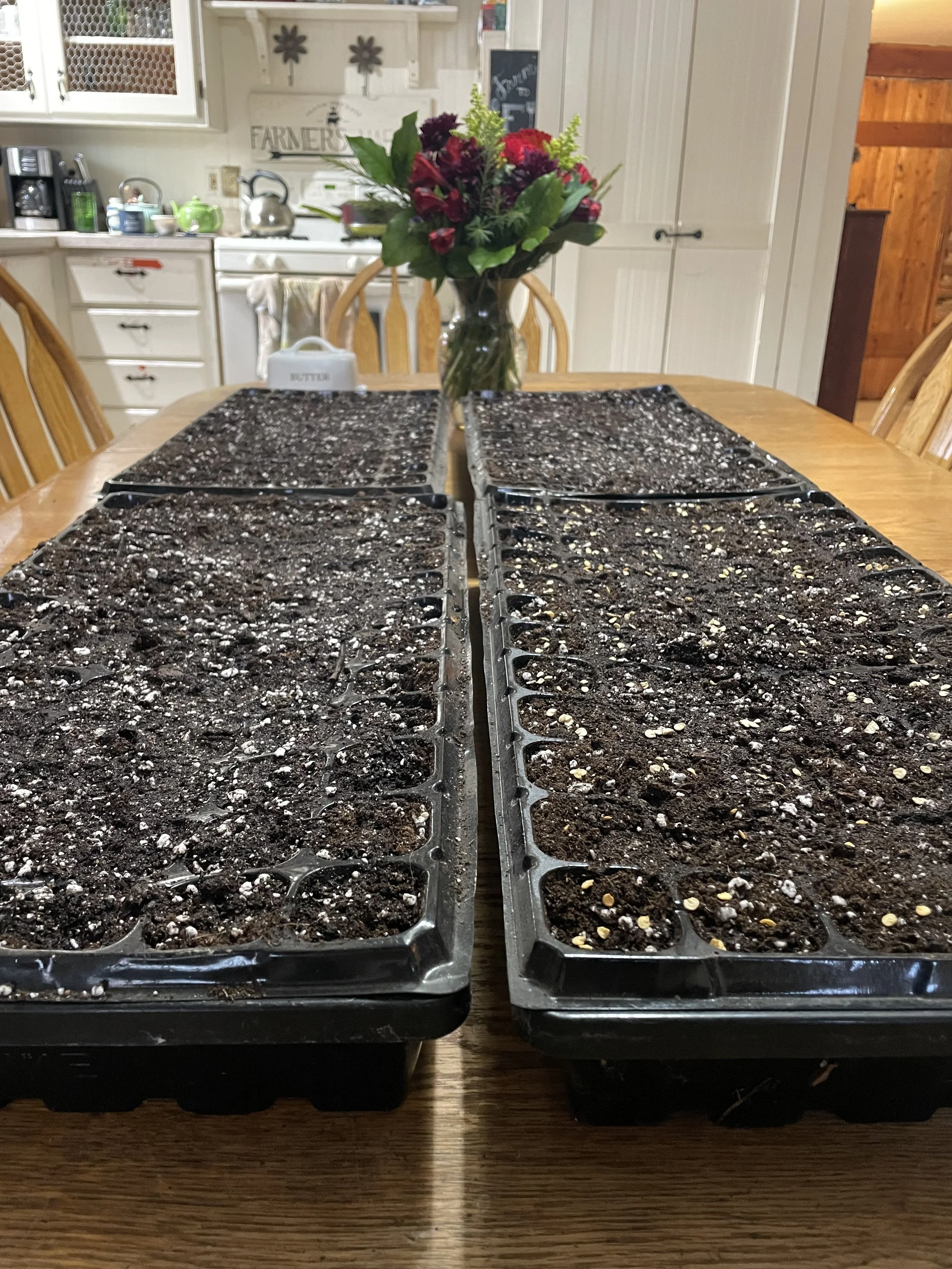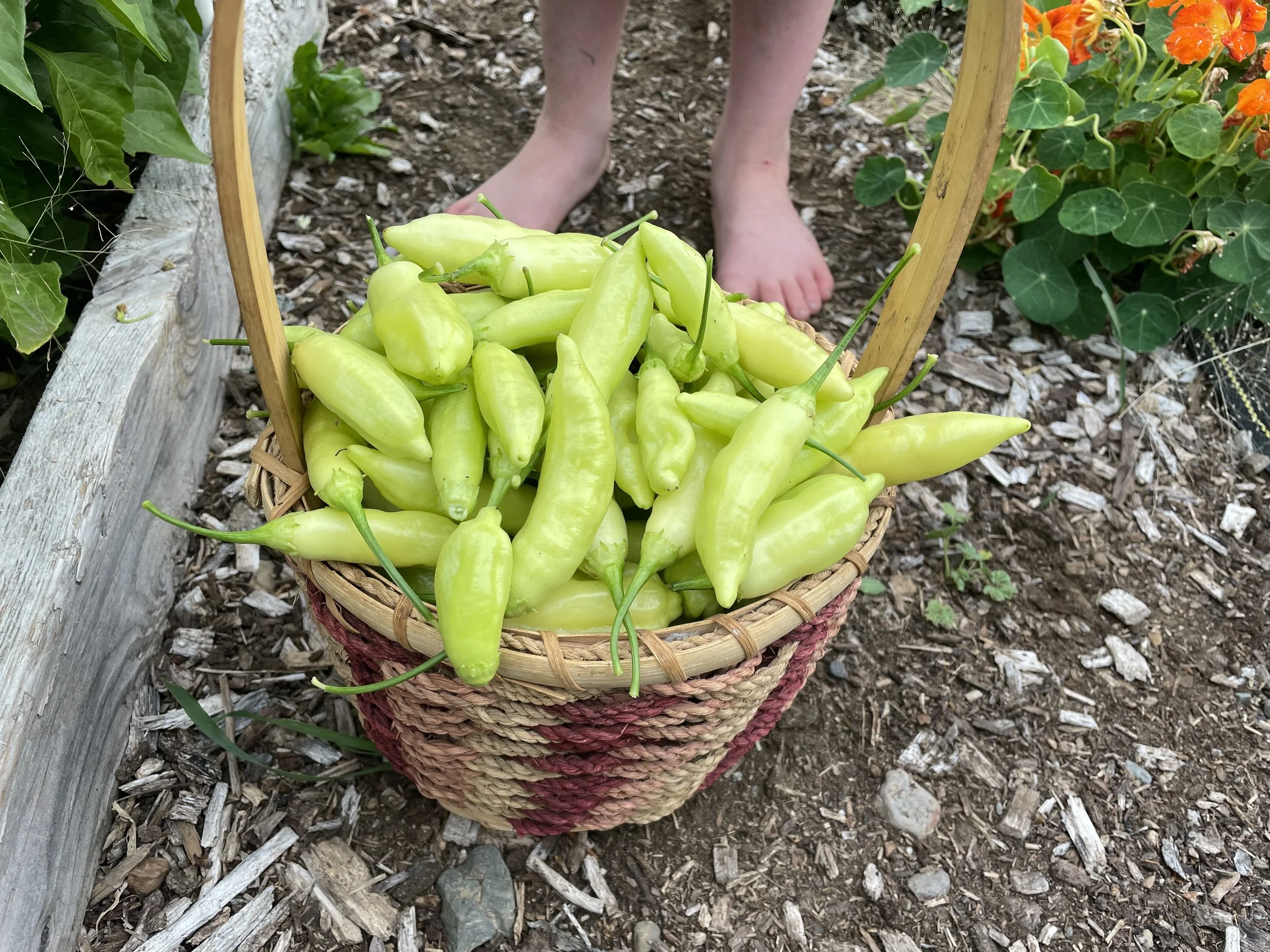Seeds To Start In January If Your Frost Date Is After May 15th
It can be difficult to know when to start seeds indoors if you’ve never gardened before. Without a bit of trial and error or a friend giving you inside intel you’re left to taking advice from YouTube channels or garden books that may or may not be close to your garden zone. Good news! I would love to be that friend and lend you my best seed starting advice for seeds to start in January if your growing zone is after May 15th. I’ve had over 15 years of trial and error, experiments and successes that have helped me build a fine tuned planting schedule! Gardening in a climate that has less than 10 full weeks of frost free weather is challenging, but you can be extremely successful with a few special tips. One of them is starting your seeds indoors, so let’s get to it. I find it helpful and less overwhelming to go month by month so let’s start in January!
Seeds started in 72 plug trays, seated in 1020 trays for bottom watering. Waiting for their plastic wrap covering.
The success of your short growing season harvest is riding on thousands of tiny little seeds. You can help them by giving them a head start inside a cozy house under grow lights. - You can also use a warm windowsill but I don’t recommend this if your seedlings are going to be indoors for more than 8 weeks. If your last frost date is any time after May 15th, you’re definitely going to want to get a head start on the growing season. There is one other thing that I should mention before telling you exactly which seeds to start in January. That is varieties matter!! Everyone knows a gardener in the south can grow lettuce as well as us Northern folks, but which types we grow makes all the difference if you want to get crisp, juicy, sweet lettuce and not bitter, wilted and bolting greens.
As I share with you which seeds to plant in January I will also mention my favorite varieties so that you don’t have to go searching if you don’t want to. Just in case you do love looking through seed catalogs just as much as I do I will give you some criteria to consider before making seed selections.
If your frost date (yes this matters WAY more than growing zones, growing zones are primarily for perennials) is after May 15th this list should help you make your best seed selections:
As close to 50 days to harvest or less as you can find
cold & frost hardiness
look for country of origin such as Canada, Russia, Siberia (these countries produce some of the best cold hardy varieties)
USA grown look for states of origin such as Montana
Look for fresh eating types, while these do not store as well usually they produce a crop more quickly than storage varieties.
Some of my favorite seeds companies are
Baker Creek Heirloom Seeds, A great company if you’d like to spend hours pouring over gorgeous seed catalogs and have the whole world of heirloom seeds at your fingertips.
Heirlooms Evermore Seed Co, An excellent choice if to many selections overwhelm you. Their seeds are hand selected for cold hardiness and perfect for people with limited time for browsing. Their seeds are packaged in Idaho! Use code ESTHERSEDEN10 at checkout for 10% off which you can use on any seed order!
Survival Garden Seeds, a new company to me however they are not to be overlooked. If you want lots of varieties, but can’t decide which to get, their prepackaged seeds are the way to go! They feature several different packages depending on what your needs are. This year we are trying out several verities from their Ultimate Medical Herb Collection. (Use this link and get 10% off)
Now that you know which characteristics to search for let’s get growing!
Seeds to start in January if your frost date is after May 15th
Long season herbs & flowers
This includes hanging basket flowers
My list includes: chamomile (for the greenhouse), lemongrass (for the greenhouse), sweet alyssum, petunias and violas.
Vegetables/ fruits
Peppers (in late January, these will live in the unheated greenhouse or under covers all their life)
Varieties: Hungarian Hot Wax, Cubanelle, Cayenne Long Thin, Tam Jalapeño, Craigs Jumbo Jalapeno, Poblano and Anaheim
Eggplant
Astrakom
Jewel Marble ( I’m trying this one out this year)
Onions
Walla Walla Sweet, Sweet Spanish and Red Globe
Leeks
Autumn Giant
Celery
Utah Tall
Celeriac
Giant Prague
Lemon Drop Peppers make a great selection if you want extremely hot citrus flavored abundance! Excellent for homemade fermented hot sauce.
Starting seeds is a pretty simple task but it can feel daunting if you haven’t tried before. Let me share a few things I’ve learned with you so you don’t have to struggle like I did.
Use a soiless seed starting medium like this one, there is very little nutrition for the plants in this kind of mix, however the seedlings won’t be spending to much time in there so don’t worry.
Most seeds do not need to actually be buried, many need light (information found on the back of each seed package) to germinate. So instead of planting the seeds in a deep hole, gently sprinkle the tiny ones on top of the soiless mix and pat them down. For slight larger seeds like peppers and onions cover with a very tiny amount of soiless mix once you’ve patted the seeds onto the soil.
Moisturize the soil before you plant not after!
Once you have hydrated the soil and planted your seeds cover each tray with a piece of plastic wrap. This will keep the moisture in which the seeds germinate and in most cases eliminate the need for watering until after the seeds sprout. Be sure to remove the plastic cover once the seeds begin to germinate to avoid mold growth.
Keep the pepper seeds on a heat mat until they germinate and for 1 or 2 days after they sprout and then turn it off. We don’t need to cook the poor little plants.
Lastly keep the seedlings growing comfortably only a few inches under your florescent grow lights. (read the instructions on your own specific grow lights to find the correct height)
These instructions are based on my own climate, house and experiences. They may not all work for you, but I hope they help you and your seedlings get off to an amazing start! Please feel free to reach out with any questions and I will do my best to answer them.
You can download my free planting calendar and follow along with me this growing season! If you are growing in a warmer climate you can simply shift these instructions by one, two, three or more weeks in order to make them work for you. Remember every garden is different. Make this your best garden year yet!
Stay tuned for the next post, seeds to start in February!
Esther, your favorite crazy plant lady



